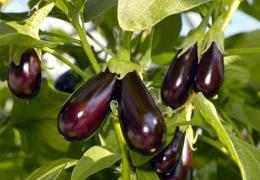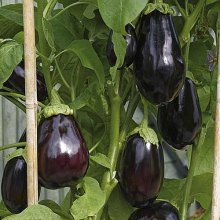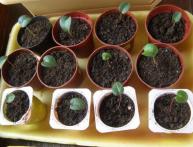Features of growing eggplant seedlings and their preparation

Eggplant is a very common vegetable native to India. The local climate is excellent for its cultivation. Eggplant grown through seedlings, which in turn grow from seeds.
Content:
Preparing seeds for sowing
Eggplant seeds must be adapted to the area where they will be planted. For sowing, you need to take those seeds that have been stored for several years. Annual varieties have a long germination period, so you need to pay attention to this when sowing. Also, when choosing seeds, you should consider the following nuances:
The first generation hybrids are considered the most stable and productive. You need to choose those seeds whose production is carried out in accordance with GOST. When purchasing, you need to ensure that the seed packaging indicates the exact quantity and date of collection.
Preparation process seeds eggplant, consists of several stages. Warming up the seeds. Seeds should be heated dry and hydrothermally. Dry warming is carried out 40 minutes before disembarkation. The seeds need to be heated in the oven, at a temperature of about sixty degrees. During hydrothermal heating, the seeds are placed in a thermos with warm water for five minutes.

The next stage of preparation is to harden the seeds. Initially, they should be placed under a wet cloth for 20 hours.Keep eggplant seeds under a cloth at room temperature. They should be placed in the refrigerator overnight and then kept at room temperature again the next day. The day before planting, the seeds are soaked in melt or rain water. After this, they need to be dried and planted.
Soil requirements
First of all, the soil must be fertile. Therefore, when digging the ground, you need to add various mineral and organic fertilizers to it. Also into the soil You can add humus, but you need to remember that eggplant seedlings are well accepted in light soil. In compacted areas, compact bushes will form, which affects the quality of mature vegetables.
Transplanting
Seedlings grown from seeds are transplanted into soil, which may have a different composition:
- A mixture of humus and turf soil
- A mixture of turf soil, peat and sand
- A mixture of peat, fermented sawdust and mullein diluted with water
After two weeks after germination, eggplant seedlings can be planted. To do this, you should prepare pots with a capacity of no more than one liter. Transplanted seedlings should be kept indoors with an air temperature of about 23 degrees. Gradually the air temperature needs to be reduced. Seedlings can be transplanted into the ground when they have ten true leaves.
Ready seedlings need to be transplanted into specially prepared holes. The weather should not be hot and cloudy. This is necessary so that the seedlings are better accepted. After three to four days you should check how well the sprouts have developed. If there are dead seedlings, then you can replace them with give a lift new.
Seedling care

Caring for seedlings consists of feeding them, watering them and loosening the row spacing. Seedlings need to be watered regularly, but more abundant watering should be done during the mass formation of fruits. Watering the seedlings should be done every week. Each watering should be accompanied by loosening the soil to a depth of 10 cm and removing weeds.
Also, during the growth process, it is necessary to periodically remove the stepsons, otherwise the eggplant fruits will have few nutrients. To prevent damage to the root system seedlings When weeding, the beds need to be covered with mulch. As mulch, you can use several layers of wet newspaper covered with dry straw.
You need to make sure that there is no excess moisture, otherwise the eggplants will be susceptible to fungal diseases. It is necessary to water the seedlings only with warm water (temperature about 30 degrees).
As for fertilizing, it must be done three to four times. This is due to the fact that young plants require large amounts of phosphorus, potassium and nitrogen. Therefore, the first fertilizing should be done in the following amount of fertilizer:
- Ammonium nitrate – 8-10g
- Superphosphate – 10g
- Potassium salt – 5-10g
For all subsequent fertilizing, fertilizer application rates must be doubled. The latest feeding is done without nitrogen fertilizers. Eggplants love heat very much, so their growing temperature should be within 20-25 degrees. During their growth, seedlings are exposed to various diseases. First of all, it is a black leg.
To reduce the susceptibility to this disease, you need to constantly loosen the soil. Also, a black leg appears when there is excess moisture in the soil.To overcome this disease, you need to frequently loosen the soil and fertilize the soil with dry stove ash. The best time for transplantation is the month of May. This means that eggplant seeds need to be sown at the end of February.
Video about proper cultivation of eggplants:










